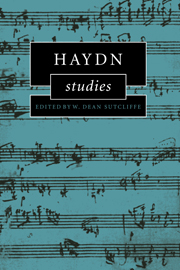Book contents
- Frontmatter
- Contents
- Preface
- Editor's note
- 1 The consequences of presumed innocence: the nineteenth-century reception of Joseph Haydn
- 2 Haydn's sacred vocal music and the aesthetics of salvation
- 3 Sentiment and sensibility in La vera costanza
- 4 Haydn as Romantic: a chemical experiment with instrumental music
- 5 Haydn's ‘Cours complet de la composition’ and the Sturm und Drang
- 6 Haydn's reversals: style change, gesture and the implication-realization model
- 7 Haydn's symphonies between Sturm und Drang and ‘Classical style’: art and entertainment
- 8 The Haydn piano trio: textual facts and textural principles
- 9 Papa Doc's recap caper: Haydn and temporal dyslexia
- 10 Haydn: the musicians' musician
- Index
8 - The Haydn piano trio: textual facts and textural principles
Published online by Cambridge University Press: 22 September 2009
- Frontmatter
- Contents
- Preface
- Editor's note
- 1 The consequences of presumed innocence: the nineteenth-century reception of Joseph Haydn
- 2 Haydn's sacred vocal music and the aesthetics of salvation
- 3 Sentiment and sensibility in La vera costanza
- 4 Haydn as Romantic: a chemical experiment with instrumental music
- 5 Haydn's ‘Cours complet de la composition’ and the Sturm und Drang
- 6 Haydn's reversals: style change, gesture and the implication-realization model
- 7 Haydn's symphonies between Sturm und Drang and ‘Classical style’: art and entertainment
- 8 The Haydn piano trio: textual facts and textural principles
- 9 Papa Doc's recap caper: Haydn and temporal dyslexia
- 10 Haydn: the musicians' musician
- Index
Summary
In a survey of the piano trios in her Master Musicians volume, Rosemary Hughes grants exceptional status to the opening movement of Trio No. 22 in A major (see Ex. 8.24 later in the chapter), as representing ‘for once a real interplay between keyboard and strings’. While this vote of approval implies a rather limited conception of the possibilities of the form, one based on the opposition of its two constituent instrumental forces, the vote is at least registered, whereas both H. C. Robbins Landon and Charles Rosen, for example, surprisingly make no comment on this Adagio. Certainly in no other Haydn trio movement is the duel between keyboard and strings so explicitly waged, in the form of a large-scale melodic dialogue that Haydn normally shunned in favour of a more closely contained exchange of ideas. The opposing melodic contributions remain mostly separate and successive until the coda (bars 55ff.). Here the violin and piano (and ultimately the cello, at bar 57) engage in a stretto whose purpose is to reconcile the previously sectional melodic interests at the point of climax. Somewhat ironically, given the prevalent textural image of the Haydn trios, this governing principle of alternation was to become the most common means of progress in later piano trios (to take just one example from many, see the opening of Ravel's Piano Trio in A minor), whereas Haydn, having hit upon a new timbral effect, as with the all-pizzicato ending to the String Quartet Op.33 No.4, or the collegno conclusion to the Adagio of his Symphony No. 67, characteristically leaves the discovery behind to move on to fresher fields.
- Type
- Chapter
- Information
- Haydn Studies , pp. 246 - 290Publisher: Cambridge University PressPrint publication year: 1998
- 1
- Cited by



